(Note: I wrote the following as a series of email messages to my family while I was conducting research during a 4-week research cruise to the deep sea hydrothermal vents in the Pacific, to give them some idea of what it’s like out there. We left shore in Manzanillo, Mexico at the beginning of November, and returned to Costa Rica about a week ago.)
DARK AND STORMY SEAS, DARK AND STORMY TUNES
We left from Manzanillo, Mexico on November 2nd and had the chance to experience a little bit of Halloween, Mexico-style, which means that every children’s costume you might see in the US was represented, except the kids’ faces were painted as skulls! So, we had princesses….WITH A SKULL FACE! Spiderman….WITH A SKULL FACE! Bride…WITH A SKULL FACE! It was actually pretty funny. The kids were asking for candy as we walked around town so we bought some lollypops and had fun handing those out to the skull-faced ankle-biters.
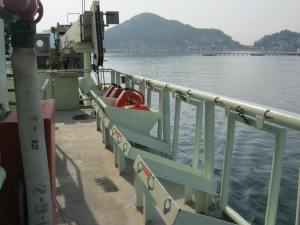
<–Goodbye, Manzanillo!
The next day, we rode out to our study site on the tattered remnants of a tropical storm that promised to spin into a hurricane as it moved north of us. As a result, the first few days at sea were rough! It was a little disconcerting to be living in a very mobile world and those of us who weren’t seasick were pretty flakey. I misplaced my hairbrush and spent two days combing my hair with a fork. Nobody noticed a change and I wasn’t sure whether to be happy or sad about that.
I love a good storm so I sat out on the back of the ship a few nights ago and played dark and stormy tunes on my small pipes as the ship dipped up-and-down on the swells. It turns out one of the other scientists on the ship plays the pipes too, and the chief engineer’s dad used to play, AND there’s a good accordion player on board, so maybe we’ll throw a ceiliedh at some point once things settle into place.
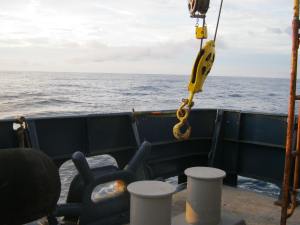
<–This was my bagpipe practice room at sea.
SMOOTH SAILIN’
The storm is finally past us, and we have a chance to compare hematomas.
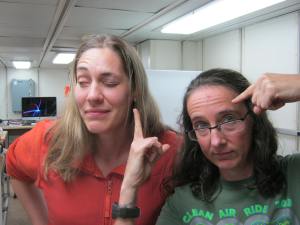
<—Jess has a nice shiner. I have a gash on my forehead. Jess is a second-year grad student of astonishing promise.
The last bit of the storm passed us last night, and when I went to my room to sleep my roommate had already taken to her bunk. Not wanting to wake her up, I tried to be quiet and dress for sleep in the dark. Of course, a huge swell hit, I tripped on a shoe, flew across the room and slammed into the wall, after which I cursed deities from at least three major religions. My roommate is from China so she may be an atheist. This is probably a good thing, given my outburst.
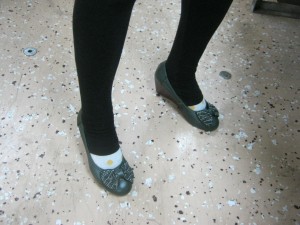
<—My roommate had the best shoes on the ship.
All the scientists have pretty much finished setting up their lab spaces—what began as a series of empty rooms with a few tables has been transformed to the usual mess of instrumentation and tubing, and looks like any other lab, except that everything is carefully tied down to the tables so it doesn’t fly around when we hit weather.
To give you a better notion of what the labs and ship are like, here is a video that I took from the isotope lab to the main lab:
https://www.youtube.com/watch?v=gyMH5Bak0Zo&feature=youtu.be
And here’s one from the main lab to the pressure lab:
https://www.youtube.com/watch?v=QZdKuLihAOs&feature=youtu.be
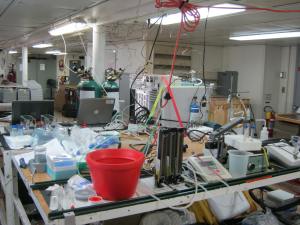
<–Science can be a mess.
One of the key bits to the work I want to do out here is the ability to incubate tubeworms under conditions similar to what they experience at the bottom of the ocean. My fantastically brilliant collaborator Pete has, with his students, created a mobile laboratory with a dozen high-pressure aquaria that can incubate the worms under high pressure, and also feed in a steady supply of the dissolved gases the tubeworms need to thrive—carbon dioxide, oxygen, and sulfide. This is a monumental feat in and of itself, but they have also added a mass spectrometer to some of the vessels to permit measuring metabolic rates.
My collaborators’ students and technicians are amazing, and it has been really cool to see them assemble the system for our first samples. The first ALVIN dive takes place during the day tomorrow, so if things go well we’ll have samples in the early evening.
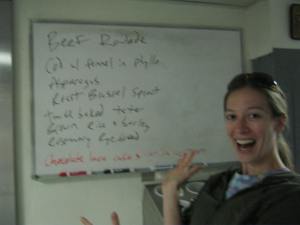
<–This is Jen, getting excited about dinner. The food *was* amazing. Jen is amazing, too. She has magical abilities to create order out of chaos.
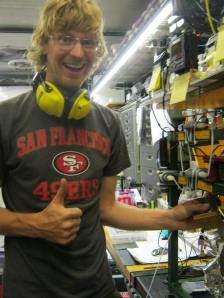
<–This is Jon, getting excited about the mass spectrometer. Jon is the most infinitely patient human in the universe. There were several times during the trip when he could have justifiably hit me in the face with a wrench, but he *didn’t*.
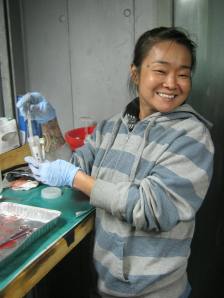
<–This is Juliana, excited about the intricacies of dissecting tubeworms, which she does like a pro. She was a little disappointed that this picture misrepresents tubeworm dissections. Given that these worms are about 40% blood, this image should have more red in it.
Fingers crossed for some good samples tomorrow!
IT’S REALLY THE ONLY WAY TO DO IT
The ALVIN collected some giant tubeworms for us to study today, and it was great to see Juliana light up when she saw them for the first time. Right now I’m settling in for a long night analyzing samples on the GC while she continues with the dissections.
The funny thing is, in order to dissect a giant tubeworm, you must first get it out of its tube. The only way to do this is to cut the bottom off of the tube and blow the worm out with your mouth. Really. Otherwise, you butcher the worm trying to get it out. Unfortunately one of the grad students who is still seasick walked into the coldroom while Juliana was blowing a giant bloody worm out of a tube; when she saw this spectacle, she turned pale, placed her hand on her stomach, and quickly left.
Field biology is not for the faint of heart.
WAKE-UP CALL
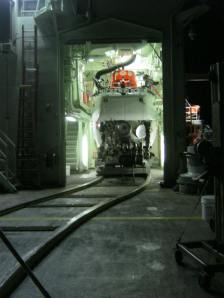
<–The submersible ALVIN, in its hangar on the ship’s fantail.
Spent yesterday running samples, troubleshooting, and doing dissections all day from 8 am until the wee hours and stumbled into bed at around 2 am-ish. Six hours later, Jessica came into my room, shook me awake and said, “hey, wake up, can you go on today’s ALVIN dive?”
When I wake up, my ‘reboot screen’ has lots of error messages (I am not a morning person) so my response was mostly expletives with a few prepositions tossed into the mix. Once reality had percolated into the miasma in my skull, I got quite excited.
It turns out the day’s scheduled dive had to be changed because of an equipment issue, and they needed somebody who had directed an ALVIN dive before, so … there you have it.
Rolled out of bed, scrubbed the worm guts out of my hair and fingernails, grabbed a donut and banana from the galley (no beverages; you do NOT want to have to pee while crammed into the rather tiny ALVIN sphere with two other people), jumped in the sub, and down into the blue we go.
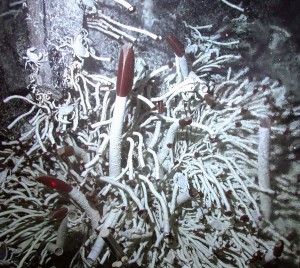
We had a great dive, collecting many water samples at the bottom, as well as a bunch of Riftia tubeworms. The ALVIN has been rebuilt; the new version has five windows instead of 3, plus some amazing high-resolution video cameras, so you can see everything clear as day and it becomes hard to fathom (ha! ha!) that you are almost two miles below the surface of the ocean.
It is very beautiful down there. The water coming up through the rocks is as warm as bathwater, and when it hits bottom water (2 celcius), it shimmers. Down there you have these massive bushes of giant tubeworms with huge red gills extending out of 6’ tubes…they kinda look like lipsticks. Ok, imagine shimmering water around giant lipsticks. Um. This isn’t quite communicating the magic and mystery of nature, but you know how it is. When something is really beautiful, words are crude tools, at best.
So, it’s dark, and silent, and shimmering, with organisms that can best be described as hallucinatory, thriving on deadly gases that are released as the Earth’s crust rips itself apart at the seams.
That works.
Going to go hit the rack. Good night, dear ones!
NOTES TO CERTAIN MANUFACTURERS FROM A SCIENTIST AT SEA
Dear Cetoni,
Thank you so much for having the foresight to install the ‘can be hurled across a lab by a rogue swell and still function’ feature into my high pressure incubator. It keeps coming in handy. I had no idea you had installed this feature (free of charge!). Thanks again.
And again. And again.
Dear Thermo-Fisher,
Those septa you are now selling are NOT made of the same stuff as the ones with the same part number that I ordered a few years ago. Those septa of years past did not mind hydrogen sulfide one bit. These new ones DO mind. After my fifth hot acid facial, I have pulled your septa out of my gas chromatograph because I have data (n = 5) that your manufacturing process has changed.
Dear Mom,
Don’t worry, the bruises will heal, and my complexion has NEVER LOOKED BETTER.
BIRDS ON DECK
As usual, we have accumulated a variety of land birds that have been blown away from land by storms. Since we are about 200 miles from land, any land or shore birds that get blown out here are probably goners, sadly. We had two egrets, which I had named Alice and Egbert, which were stilting around on the fantail, and some kind-hearted folks were feeding and watering them. When I went to go run some samples, I noticed lots and lots and lots of white feathers on the deck. Apparently, we have a third bird: a FALCON! Now we are down to two birds. Our bird population will probably consist of one very well-fed bird in a day or so.
I played Amazing Grace for Egbert at sunset.
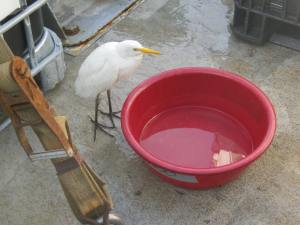
EGBERT LIVES.
Egbert the egret is still with us. I saw him stilting around the back of the ship today. Apparently the falcon disassembled a seagull, not Egbert.
Another day running samples, and then three experiments after dinner. Things are humming along. Grad student took a nice photo of a waterspout this morning.
I’m on the vampire shift (noon to 4 am) so it’s time for lunch/breakfast.
SOMETIMES REPAIRS ARE FUNNY
So, I had diaphragms (also known as septa) that were failing on the gas chromatograph (GC) and needed to come up with a work-around, since we needed to make heavier-than-anticipated use of the GC to compensate for the failure of the mass spectrometer (things break at sea. It’s just how things go).
I was griping a bit to a few other scientists: “Man, my diaphragms keep busting. I must have run through five of them today. Maybe I’m inserting them incorrectly. Maybe I need to put two in at a time.” when I noticed I was getting very strange looks from the crew.
Fixed the problem by modifying the run parameters on the GC so that back-pressure was lower at the start of the run, and did wind up doubling the diaphragms.
The crew is still regarding me with a mixture of confusion and admiration.
A grad student is doing what he can to faith-heal the mass spectrometer. This involved some smoke and a fire extinguisher earlier today. He said this was a step in the right direction.
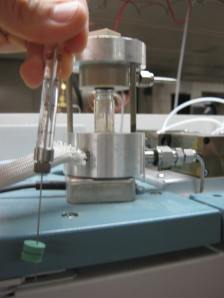
LIGHT THE NOVENA CANDLES PLEASE
Have spent three days meticulously documenting metabolic rates on four tubeworms in high pressure aquaria. Tomorrow we start opening the aquaria and a massive series of analyses and a data dump begins. I foresee rather little sleep in the next 48 hrs.
Light the novena candles and say a few kind words to the diety of your choice. I favor the elephant-headed Hindu diety Ganesha, remover of obstacles, but it’s your call.
NOTE TO MY UNCLE TO ANSWER HIS QUESTIONS
Hi Unc! Happy to answer your questions. Got my last shot on the gas chromatograph before I hit the rack and it’s great to have your company while I wait for my numbers.
The high pressure aquaria are actually flow-through systems. Each one is front-ended with a column that is equilibrated with seawater sparged with a gas mixture containing CO2, H2S, O2, and N2. The relative amounts of the four gases are controlled with mass-flow controllers, so you can design experiments where you alter the gases the critters are exposed to. We are interested in their response to sulfide. Their symbiotic bacteria oxidize the sulfide to sulfuric acid, parking the electrons on oxygen, and generating metabolic energy in the process.
Since the systems are flow-through, if you measure the dissolved gases in the column, and compare them to the dissolved gases in the water leaving the aquaria, and also measure the rate of water flow through the system, you can calculate a rate of gas consumption. When we pop open the aquaria, we weigh the tubeworm that was in it, so we can get a mass-corrected metabolic rate.
The vessels can be depressurized VERY quickly–from 3000 psi to ambient in a few seconds. Since the column feeding the aquarium is equilibrated at 1 atmosphere (not pressurized) this does not create a problem with outgassing. Since the animals do not have any gas-enclosed spaces (like a swim bladder) this does not create any huge problems for them, which is ok, since seconds after they are out I have bled them dry to study gases dissolved in their blood. I then remove the organ containing their symbiotic bacteria and go to town with that, using 14C-CO2 to measure carbon fixation rates in pressurized syringes, and 13C-CO2 to measure metabolic intermediates.
The high-pressure aquaria are housed in a trailer on the fantail. My friend and collaborator designed and built it–it is an amazing facility and I am having a blast playing with it.

<–Above the mass spectrometer are mass flow controllers that dictate the rate at which a particular gas (H2S, CO2, O2, N2, H2) is bubbled into the system.
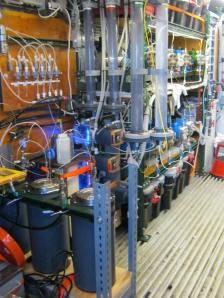
<–The ‘tubes’ in the center are equilibration columns, where the gas mixes are sparged through seawater to bring dissolved gas concentrations to a particular target value.
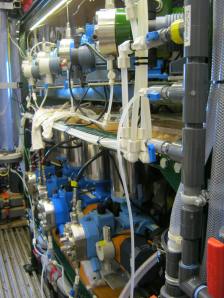
<–A battery of industrial pumps are necessary to keep the aquaria at 3000 psi
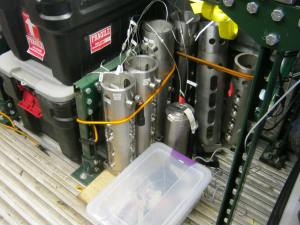
<–These stainless and acrylic canisters are the ‘aquaria’.
Inside each one is a Riftia tubeworm.
AND THE BAND PLAYED ON . AND ON. AND ON.
Hi all, finished the experiments per se, and am now analyzing dissolved gases in a pressure vessel for a friend.
Given that this was my first run-thru with tubeworms from respirometers, things went remarkably well. Will spend tomorrow doing lots of math and thinking how to make it work even better next time.
Loaded four new worms in the respirometers and will have another go-around in two or three days.
The high-pressure system I use to incubate worm guts had a faulty fitting, so I had the pleasure of enjoying a 3000 psi worm gut facial. It’s better than the five phosphoric acid facials I had a few days ago; the smell of sulfide from the worm guts adds a certain je ne sais quoi and I think some vascular tissue is stuck in my hair somewhere.
I replaced the faulty fitting with one borrowed from a friend. I asked if it was rated to 3000 psi, and he replied, “one way to find out!”
So far so good, but maybe I’ll get another facial out of this.
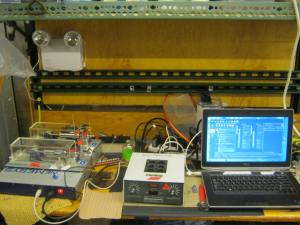
<–Coming soon to a beauty salon near you!
High-pressure bacteria incubator and worm gut atomizer!
One cool thing is that we have a bunch of grad students out here, many of which are having their first experience with an ALVIN dive. It’s great to see the excitement. Jessica, who is collaborating with me, had her first one today. First-timers have an initiation ritual when they get back to the ship after their dive; they are doused with a bucket of ice-water. We decided to have a little fun with this. Jessica is a heavy metal/horror movie/intensely mechanically inclined kinda gal, so we gave her a “Carrie”-themed return: We sat her down, gave her a bouquet made of tubing fittings, placed a crown of tubeworm tubes on her head, and doused her with a bucket of fake tubeworm blood (seawater plus food coloring).
I have about three more hours of shots on the gas chromatograph to go; there is a lonely place under my armpit so I think I’ll pipe on the fantail as they go through the system.
TODAY, I AM A REPAIR-GIRL (hey, it kinda sounds like a nerd bat-mitzvah, right?)
So, I spent the last two days in a data-frenzy. Today I crunched numbers–they look pretty good. While doing this, I also dealt with the afterglow of the data-frenzy… when you abuse equipment for a 48 hour data frenzy, it breaks. Pretty much nothing is designed specifically for doing research on deep-sea bacteria that eat sulfide. The sales rep who sold me the gas chromatograph had an interesting response when I told him what I was going to be using the system for.
He actually screamed a little.
Sulfide, phosphoric acid, seawater, and leak-testing solution have magical properties when applied together to any material out there (including gas chromatographs). I think it would probably melt diamonds.
So, since I am exposing the system to all of these compounds (except diamonds) I spent the first part of the day rebuilding the front end of the instrument because part of it had dissolved a little.
For my next trick, I will be trying out a new program on the high-pressure incubator that gave me a worm gut facial when a fitting failed yesterday. The good news is, if it works, it will actually be an improvement over what I had originally planned. The malfunction, as for the gas chromatograph, resulted from using the instrument differently than its designed function. The system includes 10,000 psi syringes that are used to perfuse ‘difficult biological samples’. I have no idea what sort of biological sample needs 10,000 psi to push fluid through it, but I have a sad image of an inflated rat in my head.
When I told the German engineers who helped me design a modified version of their usual system what I was going to use their system for, there was about 2-3 minutes of awkward silence, which is probably the German equivalent of a little scream.
GEARING UP FOR MORE MAYHEM TOMORROW
Have four more tubeworms in pressurized aquaria under different conditions that I’ll be analyzing tomorrow. Today has been a mad dash to get everything ready for another two-day data slam, while monitoring the conditions in the aquaria by taking samples and shooting them into the gas chromatograph every 30 minutes. Today is one of those days where I feel a little like J. Alfred Prufrock, but it isn’t coffee spoons, it’s GC shot times.
On a sad note, Egbert took fright and lept into the ocean yesterday, where he was promptly eaten by a shark. I took this as a good reminder not to take the universe too personally. I’ll play him a lament later.
YOU WIN SOME, YOU LOSE SOME, AND SUMMER’S GOOD QUESTION
Data slam #2 is done! We learned a great deal, for better and for worse. It turns out our pressure aquaria for tubeworms are great for tubeworms, but are also Club Med for other bacteria too (e.g., not just the ones we are trying to study, which live inside the tubeworms). These other bacteria have completely overgrown things and swamped out any signal we could pick up from the tubeworms. This was an unhappy discovery made last night and slept on by all (myself plus grad students) a little fitfully between 4 and 8 am. Once we all awoke and gathered, we put our heads together to come up with a possible way to deal with the situation and have the appropriate control experiments running right now. That’s the way biology research goes; you set up an experiment as best you can, but sometimes life has its own agenda.
Summer had a great question, and I’ve pasted my response to it if anybody else is curious.
Worms, why worms. Good question. The deal is, the worms have symbiotic bacteria within; these bacteria take the gases present at the vents (sulfide, oxygen, carbon dioxide and perhaps also hydrogen) and synthesize sugars and amino acids, which the worm feeds on. The symbiotic worm/bacterial system functions similarly to a plant (except with a plant it’s ‘chloroplasts’ and ‘plant’, not ‘bacteria’ and ‘worm’. The bacteria use the same biochemistry as chloroplasts do to fix carbon dioxide, but it seems there’s much more to the story than that, and we are trying to clarify it. Doing so might help us
understand plants a little bit better, and will certainly help us understand the ecophysiology of carbon fixation by microorganisms in general–why do some microbes fix carbon one way, and why do others use a different method? Different biochemistries for this process have dominated at different periods in Earth history, and we’re trying to figure out why.
If crazy basic scientists like me can sort out the ecophys of carbon fixation, then other more practically-oriented people (e.g., engineers) could perhaps find ways to use this for carbon sequestration or for biosynthesis (e.g., using natural or engineered microorganisms to replace environmentally obnoxious technologies for molecule synthesis).
Thus, worms.
A GOOD DAY AFTER A ROUGH ONE
Thanks for the birthday wishes yesterday, I really appreciated them! Spent the first part of the day running samples for a collaborator and then tried to do a very complicated experiment in the evening. Unfortunately, several late-nighters in a row took their toll on my cognitive abilities and I made a bunch of mistakes. The coup de gras was a poor choice in valve configurations on a high pressure system that resulted in…. you guessed it….another worm gut facial. I decided to can the experiment before I got to the dangerous part with the radioactive chemicals (rolling eyes), and told one of my buddies out here that my brain had ‘no science left in it’. I cleaned up the mess, repaired the busted fitting, and called it a night.
As a nice balance for the rough previous day, I had a great time directing another ALVIN dive today. This time, we had a manta ray and two remoras greet us when we hit the waves in the sub. The manta kept zipping by us—it seemed genuinely curious. Never seen one of those before—what a gift!
The other scientist in the sub had never been in the ALVIN before and it was really cool to see her enthusiasm! Halfway through the dive we took a break for lunch and I grabbed a hand-camera and took a bunch of pictures of her, so she is one of the few people on the planet to have her photo taken while eating a pb&j on the ocean floor with a black smoker out the window! I’m not sure anybody else has a profile pic like that on Facebook.
Spent the dive collecting more tubeworms as well as water samples for collaborators. We also grabbed a rock formation called a ‘beehive’ for a geologist, and roasted a hydraulic line in a black smoker as we did so (ooooooooops). This resulted in having to terminate the dive, but we’d already accomplished 99% of our goals, so that was ok.
Everybody seems happy with the samples we collected for them (whew), so it’s a happy night on our metal-island-full-of-nerds.
Tomorrow is our last dive, and then we begin a six-day transit to Costa Rica. We’re going to keep doing experiments for the next four days (we have tubeworms in pressure vessels that we have big plans for), and then it’s two days frantically stuffing our gear back into crates for shipping back home again.
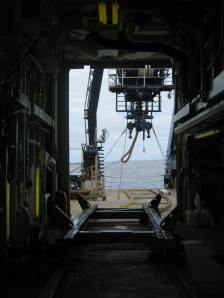
ROLLING HOME
Our last dive is over, and the ship is high-tailing it to Costa Rica!
Did a hu-u-u-u-ge 14-hour experiment all day long that made me feel like I was flying five airplanes at once. Despite two leaky fittings and three short-circuits, I managed to complete the experiment successfully! We’ll see how things go when the numbers start rolling in, but I’m happy the science appears to have gone well (only somebody doing deep-sea research would consider two high-pressure leaks and sporadic short circuits = “going well”. It does change one’s perspective). One of the things about research is that oftentimes it’s hard to tell if things went well or not—there’s the experiment, then there’s a delay to process the samples, and then, later, you get the results. I’ll take it as a good sign that I didn’t give myself another 3000 psi worm gut facial.
We have tubeworms still living in the high-pressure aquaria that we’ll continue to work on for the next few days. I may have one less worm to process as the pump feeding its aquarium had a diaphragm rupture and it’s likely this worm got a pump oil bath! That’s the way it goes. Still have three other ones going, so I’ll have enough to do to stay out of trouble.
Kinda.
We’re going to be incubating tubeworms with hydrogen gas to see if their bacteria can use this as an energy source. Hehehehe. Hydrogen gas. We have a hydrogen sensor in the pressure van to make sure it doesn’t build up in there and blow us to smithereens. We tested this safety system yesterday by blowing the hydrogen line on its sensor, which resulted in a screaming siren and flashing lights. It works!
I have about three hours of gas chromatograph shots to do tonight, so I’ll be sitting here rolling through ‘em and watching the numbers come in. I’m thinking of grabbing a trashy novel from the ship library to enjoy while I do this.
NO HINDENBERG OF THE HIGH SEAS
Well, we finished up the big huge all-day hydrogen experiment and we didn’t blast the pressure van off the back of the ship.
We’ll try harder next time.
FINIS
Am finishing up the last of the experiments (!) and will take my final readings on various instruments tomorrow. I am ready to take a bit of a break from 18 hour workdays! My complexion is a wreck (too many facials) and my hair looks like I stuck my finger in a socket.
I found out I’m not the only one who decided not to shave my legs–shaving in a tiny shower on an enthusiastically rocking ship is a death-defying experience. I’d rather play with hydrogen gas. Less dangerous. Instead of risking blood loss, we may be throwing a ‘shaving party’ on the fantail in the next couple of days.
Come join us! Who wouldn’t want to shave along with a bunch of ragged female scientists?
It’s been a wonderful and intense trip. Riftia told us some secrets, and kept some to itself.
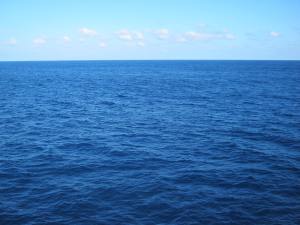
<–Welcome to Earth. Really.
This is what most of the planet looks like.
HOME IS WHERE THE CATBOX IS
Spent four days wrapping things up (literally) on the ship, packing gear into boxes, scrubbing the radioisotope van, organizing shipments, and helping pack up the pressure van.
We got to Costa Rica a day early, so some of the other scientists and I took a tour of a rainforest (!). One of the scientists with us (Jon) is an expert on ants (and the deep sea too, go figure); given that ants are the dominant fauna in a rainforest, he was the perfect person to have on this tour. Any time the poor tour guide pointed out monkeys and sloths, one of us would spot some ants and it’d be game over (“ANTS! Hey Jon, what kind is this?”).
The courier for the samples fell through at the last minute (they couldn’t figure out what sort of documents were necessary for shipping deep-sea samples) so I had to organize dry ice and fly with them, which makes for an interesting situation with customs at the airport (the less you explain, the better; it’s a good idea to smile sweetly and say ‘yes’ a lot, unless they mention commercial value or agriculture, and then it’s a good idea to say ‘no’ a lot.).
Got lucky, and the samples are now safely tucked in my -80 freezer at lab.
Amy was a huge hero and picked me up at the airport.
Hope I communicated somewhat the nature of a research cruise–always always always I feel very grateful to be out there, and am awed by the beauty of the ocean … and … it’s an insane amount of work, where things turn on a dime with some regularity and you have to immediately come up with a solution (e.g., broken mass spec, problematic gas chromatograph, overgrowth in pressure vessels). You use *all* of your intellectual bandwidth nonstop the whole time you are out there, you are physically challenged by the heavy equipment needed to do high pressure work, as well as beaten up a bit by the ship when things get rocky.
I get thoroughly reacquainted with my intellectual and physical limits while I’m out there, and I’ve spent the last few days feeling like I have a science hangover.
It was a good cruise, about as insane as is usual, and I made some dear friends among my colleagues.
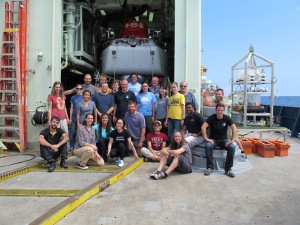
I am sitting at my kitchen table and it feels like my house is rocking. It’ll be this way for a few days.
Time to hit the rack (no ladder!).
Thank you for sharing the trip with me!
KT
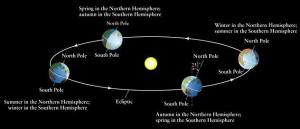




















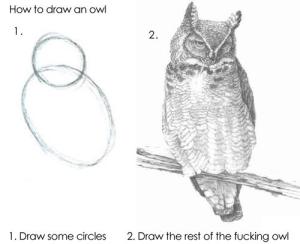
![IMG_1632[1]](https://meaningamidstmeasurement.files.wordpress.com/2014/10/img_16321.jpg?w=300&h=224)